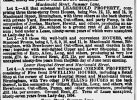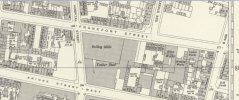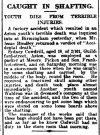-
Welcome to this forum . We are a worldwide group with a common interest in Birmingham and its history. While here, please follow a few simple rules. We ask that you respect other members, thank those who have helped you and please keep your contributions on-topic with the thread.
We do hope you enjoy your visit. BHF Admin Team
You are using an out of date browser. It may not display this or other websites correctly.
You should upgrade or use an alternative browser.
You should upgrade or use an alternative browser.
Picken Matthew
- Thread starter WriteTheBook
- Start date
Pedrocut
Master Barmmie
I have not read the attachments yet but something occurred to me.
In 1895 Matthew was at 24 Frankfort Steet and back of 24 was Sarah Cudd, cycle fittings, and in 1900 at the back there was The Wizzard Vacuum Manufacturers!
This may be a complete red herring but the Wizzard Dust Extractor Company Limited of Frankfort Street went into voluntary liquidation in November 1914 and was put up for sale. Could Picken have bought it and used as part of the expansion.
Richard Dye
master brummie
If they had wire drawing processes back in the day, oil in many cases was used to quench the wire and would tend to smoke. The oil would be reused and each time get a little dirtier and cause more smoke. In some cases chemicals would be added to the oil to condition the wire, this in turn would make for “smelly” smoke.Can you imagine how much smoke they must have been churning out to be a nuisance when everyone else was churning it out!
MalcolmWalker
New Member
Sara, what a fascinating story! It sounds like Matthew Picken was quite an entrepreneur. You're right to try and get the details of Frankfort Street correct, especially as it relates to the growth of his business.
Back-to-back housing in Birmingham was notorious for being cramped, so a backyard factory seems unlikely unless those higher numbers were significantly different. The numbering system might hold the key. Could the street have been renumbered at some point? That might explain why no one in the later threads mentioned the 140s.
The local archives are your best bet for finding deeds and old maps. They might have plans that show the layout of those higher-numbered properties. Good luck with your research and your book!
Back-to-back housing in Birmingham was notorious for being cramped, so a backyard factory seems unlikely unless those higher numbers were significantly different. The numbering system might hold the key. Could the street have been renumbered at some point? That might explain why no one in the later threads mentioned the 140s.
The local archives are your best bet for finding deeds and old maps. They might have plans that show the layout of those higher-numbered properties. Good luck with your research and your book!
pjmburns
master brummie
Welcome to the Forum.Sara, what a fascinating story! It sounds like Matthew Picken was quite an entrepreneur. You're right to try and get the details of Frankfort Street correct, especially as it relates to the growth of his business.
Back-to-back housing in Birmingham was notorious for being cramped, so a backyard factory seems unlikely unless those higher numbers were significantly different. The numbering system might hold the key. Could the street have been renumbered at some point? That might explain why no one in the later threads mentioned the 140s.
The local archives are your best bet for finding deeds and old maps. They might have plans that show the layout of those higher-numbered properties. Good luck with your research and your book!
If you check post # 3 you will see there was confusion over schedule numbers (148, 151etc) and house numbers (not shown on earliest censuses).
Last edited:
Pedrocut
Master Barmmie
The first mention of Macdonald Street that I can find is In August 1847, and Matthew is listed there in the 1851 census. As Janice says the number is not given but I would hazard a guess that he was one of the first to move into the street.
In 1847 there is an auction for “the shells of 6 new three quarter houses, buildings in a forward state. Properties in excellent situation and when finished will command good tenants, about 750 yards of land. Later in May 1954 there is the sale as shown below. In this it can be seen that Nos 6 to 11 have brewhouses and outffices, small garden in rear, together with well-lighted upper and lower shopping.
Mathew looks to have been an artisan who would have a fair standard of living before moving to Macdonald Street, he could have been one of those good tennants predicted.

In 1847 there is an auction for “the shells of 6 new three quarter houses, buildings in a forward state. Properties in excellent situation and when finished will command good tenants, about 750 yards of land. Later in May 1954 there is the sale as shown below. In this it can be seen that Nos 6 to 11 have brewhouses and outffices, small garden in rear, together with well-lighted upper and lower shopping.
Mathew looks to have been an artisan who would have a fair standard of living before moving to Macdonald Street, he could have been one of those good tennants predicted.

Pedrocut
Master Barmmie
A quick look at the 1851 census for Macdonald St. There is a Pocket book maker, Steel toy maker, Japanner, Picken the Machine fitter, Silver plater, Blacksmith, Paper mache worker and amongst a few others a Gun polisher. They look like skilled workers who could use their properties for business.
Pedrocut
Master Barmmie
If you do a search from 1860 +or- 10 years in the directories on ancestry for Matthew Picken it comes up with 3 interesting results.
In the 1862 Corporation Directory under Boring, turning and planing Mills it gives MP as at Morgan's mill, Macdonald St. One entry in 1868 Kelly's under Machinists it gives MP at Macdonald St. and 86 Summer Lane. Also in this directory under Macdonald Street it gives MP after Gee Street and Lower Hospital Street as machinist.
I seem to remember that Morgan Buildings have been mentioned somewhere.
86 Summer Lane mention is interesting. Looking in the same directory under 86 Summer Lane it does show MP !
In the 1862 Corporation Directory under Boring, turning and planing Mills it gives MP as at Morgan's mill, Macdonald St. One entry in 1868 Kelly's under Machinists it gives MP at Macdonald St. and 86 Summer Lane. Also in this directory under Macdonald Street it gives MP after Gee Street and Lower Hospital Street as machinist.
I seem to remember that Morgan Buildings have been mentioned somewhere.
86 Summer Lane mention is interesting. Looking in the same directory under 86 Summer Lane it does show MP !
pjmburns
master brummie
Morgan Mills referred to here
I'm new here so please forgive me if I have posted this in the wrong place.
My family (Ingram) were pearl workers, living in a court off MacDonald Street in the 1850/60's. I found a newspaper article (1858) linking one of them to an accident at "the pearl ornament works of Mr. Benjamim I. Morgan, Macdonald Street" & wondered if anyone knew anything more about the establishment or location.
My family (Ingram) were pearl workers, living in a court off MacDonald Street in the 1850/60's. I found a newspaper article (1858) linking one of them to an accident at "the pearl ornament works of Mr. Benjamim I. Morgan, Macdonald Street" & wondered if anyone knew anything more about the establishment or location.
Richard Dye
master brummie
Good question!This may be a complete red herring but the Wizzard Dust Extractor Company Limited of Frankfort Street went into voluntary liquidation in November 1914 and was put up for sale. Could Picken have bought it and used as part of the expansion.
WriteTheBook
Matthew
Thanks for your reply Malcolm. The factory number was 24, it seems that I was looking at the serial numbers not the house numbers on the census! I'm planning a trip to the Birmingham library to take a look at old records and get some colourful details for the book.Sara, what a fascinating story! It sounds like Matthew Picken was quite an entrepreneur. You're right to try and get the details of Frankfort Street correct, especially as it relates to the growth of his business.
Back-to-back housing in Birmingham was notorious for being cramped, so a backyard factory seems unlikely unless those higher numbers were significantly different. The numbering system might hold the key. Could the street have been renumbered at some point? That might explain why no one in the later threads mentioned the 140s.
The local archives are your best bet for finding deeds and old maps. They might have plans that show the layout of those higher-numbered properties. Good luck with your research and your book!
WriteTheBook
Matthew
Thank you Mike, another lovely find.
WriteTheBook
Matthew
I like it! Yes, he could well have done, except in 1914 this would have been his grandson Albert Picken. You'd have thought the likes of the Pickens with their dirty industry, would have kept the vacuum cleaner business busy!Good question!
WriteTheBook
Matthew
Good question!
This would have been Matthew's grandson Albert Picken, who joined the business aged 13 years old. Yes! I think it's highly likely that they did buy Mr Wizzard out. By the 1960s, my brother recalls playing in the back-to-backs behind the factory and the footprint of the factory took up a fair amount of space along Frankfort Street.This may be a complete red herring but the Wizzard Dust Extractor Company Limited of Frankfort Street went into voluntary liquidation in November 1914 and was put up for sale. Could Picken have bought it and used as part of the expansion.
WriteTheBook
Matthew
Pedrocut, thank you so much for all this information and directions to expand my searches on Ancestry. All this information really helps me to see how Matthew built up his business, he must have been quite an entrepreneur despite his humble beginnings. His father was a labourer as were his brothers. He escaped on foot to build himself a brighter future in Birmingham at the age of 10. He certainly did that. The information being uncovered in this thread is really helping me to build this remarkable story. Thank you.If you do a search from 1860 +or- 10 years in the directories on ancestry for Matthew Picken it comes up with 3 interesting results.
In the 1862 Corporation Directory under Boring, turning and planing Mills it gives MP as at Morgan's mill, Macdonald St. One entry in 1868 Kelly's under Machinists it gives MP at Macdonald St. and 86 Summer Lane. Also in this directory under Macdonald Street it gives MP after Gee Street and Lower Hospital Street as machinist.
I seem to remember that Morgan Buildings have been mentioned somewhere.
86 Summer Lane mention is interesting. Looking in the same directory under 86 Summer Lane it does show MP !
WriteTheBook
Matthew
Thank you Richard. My son trained as a metal fabricator so I'll quiz him, meanwhile, I'm off to Google this!If they had wire drawing processes back in the day, oil in many cases was used to quench the wire and would tend to smoke. The oil would be reused and each time get a little dirtier and cause more smoke. In some cases chemicals would be added to the oil to condition the wire, this in turn would make for “smelly” smoke.
WriteTheBook
Matthew
Wow! That's a find. Thank you. Worth including, I reckon.By January 1920 the Birmingham Gazette reports of a fatality at Frankfort Street. The premises were now regarded as a factory.
View attachment 195515
WriteTheBook
Matthew
Oh lovely Sarah Sophia. Bless her for suffering so long. Are you finding these in Ancestry Pedrocut? I'm loving them. It really colours in their life for me.
Richard Dye
master brummie
Well done Pedro!Corns and Bunions, advert for chiropodist in Coventry Weekly Times, August 1859.
Mrs Picken gets relief…
View attachment 195536
WriteTheBook
Matthew
Thank you. I'm really grateful for these snippets but aware I need to join in too! Decided to use the youth who died story in Book 1. It gives a lovely opportunity to start to bring in another thread that weaves its way through the future story.In the Newspaper Archives on line.
WriteTheBook
Matthew
Thanks for the Kelly's Directories tip. The factory went into liquidation after 6 years of horrifying upheaval for my parents. The did everything to keep the company solvent although they were in their 70s. The bank finally called in their loans in 1996. Almost 200 years after Matthew started the business.This would be from the Kelly’ Directories of 1895 and 1900 available on Ancestry with subscription.
When did the firm close, sometime in the mid 90s ?
Thanks for the Kelly's Directories tip. The factory went into liquidation after 6 years of horrifying upheaval for my parents. The did everything to keep the company solvent although they were in their 70s. The bank finally called in their loans in 1996. Almost 200 years after Matthew started the business.
very sad and upsetting but to keep a business running for 200 years is also something to be proud of...
lyn
WriteTheBook
Matthew
It's a book of fiction based on the truth of how the business grew over 200 years. I WISH I could find something out about Joe but he hasn't appeared in my Ancestry searches and I didn't want to get sucked down rabbit holes instead of writing! I am prone to enjoying a rabbit hole but I must get on with it!Does the book cover the just Matthew’s part in the business or cover the 200 years ?
Is there anything else you know about Joe Murdoch ?
WriteTheBook
Matthew
When I look at the challenging times for industry and the UK just in the 20th century alone, it is an achievement.very sad and upsetting but to keep a business running for 200 years is also something to be proud of...
lyn
Richard Dye
master brummie
Yes, it seems that after the 60’s much of what made industry in the UK great started to unravel.When I look at the challenging times for industry and the UK just in the 20th century alone, it is an achievement.




